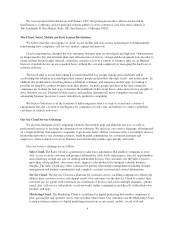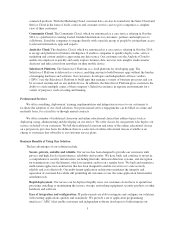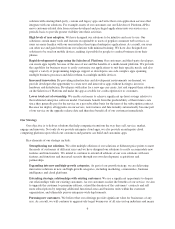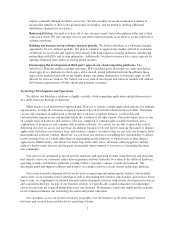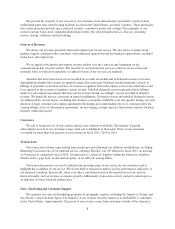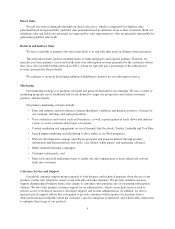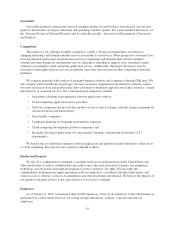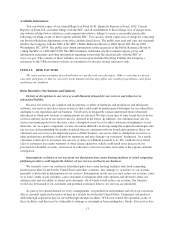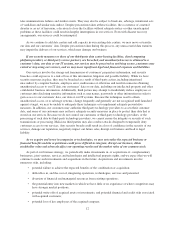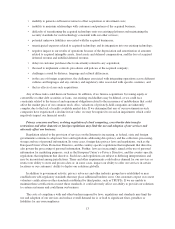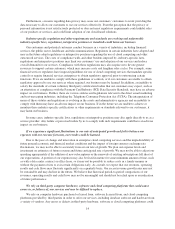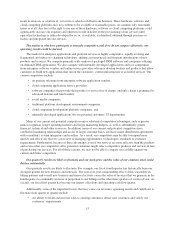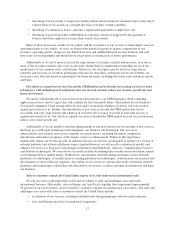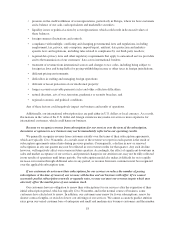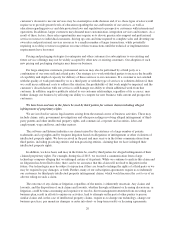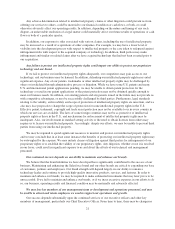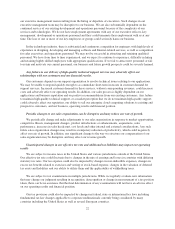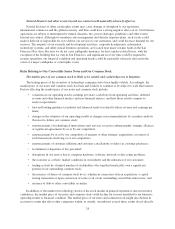Salesforce.com 2015 Annual Report Download - page 20
Download and view the complete annual report
Please find page 20 of the 2015 Salesforce.com annual report below. You can navigate through the pages in the report by either clicking on the pages listed below, or by using the keyword search tool below to find specific information within the annual report.Furthermore, concerns regarding data privacy may cause our customers’ customers to resist providing the
data necessary to allow our customers to use our services effectively. Even the perception that the privacy of
personal information is not satisfactorily protected or does not meet regulatory requirements could inhibit sales
of our products or services, and could limit adoption of our cloud-based solutions.
Industry-specific regulation and other requirements and standards are evolving and unfavorable
industry-specific laws, regulations, interpretive positions or standards could harm our business.
Our customers and potential customers conduct business in a variety of industries, including financial
services, the public sector, healthcare and telecommunications. Regulators in certain industries have adopted and
may in the future adopt regulations or interpretive positions regarding the use of cloud computing and other
outsourced services. The costs of compliance with, and other burdens imposed by, industry-specific laws,
regulations and interpretive positions may limit our customers’ use and adoption of our services and reduce
overall demand for our services. Compliance with these regulations may also require us to devote greater
resources to support certain customers, which may increase costs and lengthen sales cycles. For example, some
financial services regulators have imposed guidelines for use of cloud computing services that mandate specific
controls or require financial services enterprises to obtain regulatory approval prior to outsourcing certain
functions. If we are unable to comply with these guidelines or controls, or if our customers are unable to obtain
regulatory approval to use our services where required, our business may be harmed. In addition, an inability to
satisfy the standards of certain voluntary third-party certification bodies that our customers may expect, such as
an attestation of compliance with the Payment Card Industry (PCI) Data Security Standards, may have an adverse
impact on our business. Further, there are various statutes and regulations relevant to the direct email marketing
and text-messaging industries, including the Telephone Consumer Protection Act (TCPA). The interpretation of
many of these statutes and regulations is evolving in the courts and administrative agencies and an inability to
comply with them may have an adverse impact on our business. If in the future we are unable to achieve or
maintain these industry-specific certifications or other requirements or standards relevant to our customers, it
may harm our business.
In some cases, industry-specific laws, regulations or interpretive positions may also apply directly to us as a
service provider. Any failure or perceived failure by us to comply with such requirements could have an adverse
impact on our business.
If we experience significant fluctuations in our rate of anticipated growth and fail to balance our
expenses with our revenue forecasts, our results could be harmed.
Due to the pace of change and innovation in enterprise cloud computing services and the unpredictability of
future general economic and financial market conditions and the impact of foreign currency exchange rate
fluctuations, we may not be able to accurately forecast our rate of growth. We plan our expense levels and
investment on estimates of future revenue and future anticipated rate of growth. We may not be able to adjust our
spending appropriately if the addition of new subscriptions or the renewals of existing subscriptions fall short of
our expectations. A portion of our expenses may also be fixed in nature for some minimum amount of time, such
as with a data center contract or office lease, so it may not be possible to reduce costs in a timely manner or
without the payment of fees to exit certain obligations early. As a result, we expect that our revenues, operating
results and cash flows may fluctuate significantly on a quarterly basis. Our recent revenue growth rates may not
be sustainable and may decline in the future. We believe that historical period-to-period comparisons of our
revenues, operating results and cash flows may not be meaningful and should not be relied upon as an indication
of future performance.
We rely on third-party computer hardware, software and cloud computing platforms that could cause
errors in, or failures of, our services and may be difficult to replace.
We rely on computer hardware purchased or leased from, software licensed from, and cloud computing
platforms provided by, third parties in order to offer our services, including database software and hardware from
a variety of vendors. Any errors or defects in third-party hardware, software or cloud computing platforms could
14


